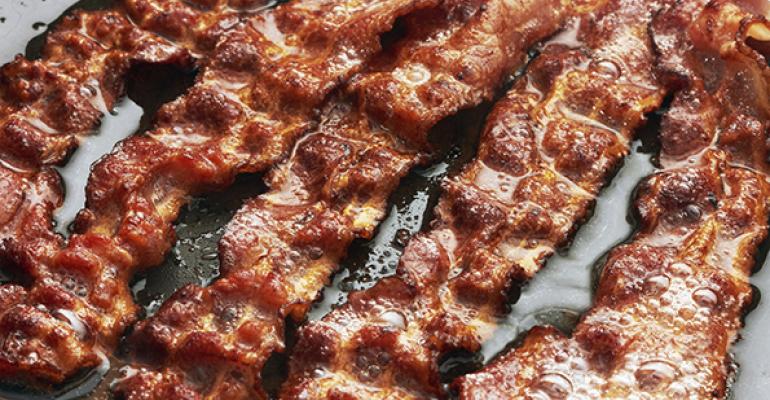 NRN senior food editor Bret Thorn relates the growth in foodie culture to our obsession with monsters.
NRN senior food editor Bret Thorn relates the growth in foodie culture to our obsession with monsters.
Nancy, one of my earliest memories is of me standing on a stool and watching my dad fry bacon. I was around three years old, the same age at which I declared myself the Boss of the Monsters.
Food and monsters. Those were my passions as a kid, and today they’re among America’s favorite pastimes.
I’ll get to food in a moment, but please indulge me by letting me take a brief look at monsters first.
First there was vampire mania, which seems to have given way to a zombie fever that is well and truly mainstream: More than 17 million people watched last year’s season premiere of the AMC zombie series “The Walking Dead,” which was about 2.5 million more people than watched Sunday Night Football that evening. That’s crazy. How can monsters possibly be more popular than football, even for one night?
And people spend money on monsters. The National Retail Federation estimates that Americans spent $7.4 billion on costumes, decorations, candy, etc. last year for our annual monster festival, Halloween.
All this monster mania makes me feel like I’ve been robbed a little bit, like I’ve had my own special pleasures taken away and given to everyone else. In the process, those creatures I loved so much have been dumbed down.
These days, vampires are cute.
Vampires aren’t supposed to be cute, Nancy. Sexy, yes, but also evil: They suck people’s blood and turn them into demons.
Zombies, I’m happy to report, are still really scary, but for how long? There’s already been one zombie-related romantic comedy: “Warm Bodies,” released in 2013. When will zombies start to crack jokes?
Never mind, they already do on the Comedy Central show “Ugly Americans.”
I bet you see where I’m going with this. If monsters are a craze (they are), then food is an entrenched obsession. Sure, people spend $7.4 billion on Halloween, but they spend an estimated $709.2 billion in restaurants each year, according to the National Restaurant Association, making it 4 percent of the gross domestic product.
More important than that, food is everywhere. Mintel estimates that 29 million Americans have posted a picture of food or drink from a restaurant on social media.
There are two large cable networks — the Food Network and the Cooking Channel — devoted entirely to food, an entire genre of cooking competition shows, foodie episodes of “South Park” and “The Simpsons,” and more than two million food blogs.
How does that make me feel?
Food writer John Lanchester summed it up in the Nov. 3, 2014, issue of The New Yorker quite well:
“[I]magine that you’re fascinated by model trains. You’re on fire with interest, you think about them all the time, they’re your consuming passion. But then, over about twenty years, the entire culture becomes obsessed with model trains. The model-train blogosphere grows exponentially. Model-train makers are plastered all over the covers of magazines, and stage train-building smackdowns on TV, and are treated as the new rock stars. Might you, in your private heart, think that maybe the whole model-train thing, still of tremendous interest to you, has somehow got a bit out of hand? That’s where I feel food is today.”
Has it been dumbed down? Well, when people watching cooking competitions care more about the drama than the food, I’d say that’s dumbing down.
I used to attend food-related events and try new dishes with others who were interested in the food’s cultural origins and the techniques used to make it. Recently, I went to a dinner at a newly revamped restaurant, tasted shrimp cooked with garlic, butter and wine, commented that it was cooked with garlic, butter and wine, and the restaurant’s publicist, also a self-styled food blogger, asked how I knew that.
I explained that I tasted it. She was impressed.
That’s dumbing down.
The countless food and wine festivals held across the country now bore me because they’re about the attending celebrities, who happen to be chefs, not about the food or the wine.
But am I missing the forest for the trees, Nancy? Sure, once something, anything, becomes popular it attracts people who are interested in it for its fashionableness rather than its substance. But still, it’s undeniable that food in the United States has gotten better in the past decade — even in the past few years. And not just tastier, but more varied and healthful.
In July, The New York Times reported that American calorie consumption seems to have peaked around 2003, and is now in steady decline. Considering that obesity is the country’s most serious health issue, that’s excellent news.
So what do you think, Nancy, am I just being selfish to resent that my private obsessions have gone mainstream, or has the food fad gone too far?
Food as entertainment
 The following is Kruse Company president Nancy Kruse’s take on foodie culture.
The following is Kruse Company president Nancy Kruse’s take on foodie culture.
I must admit you’ve thrown me a curve here, Bret. In fact, you’ve lobbed several in my direction. Just when I’d settled in for a nice, cozy reminiscence of your childhood, you detoured to the living dead; and then when I’d moved to the edge of my seat with your disquisition on vampires, you segued to foodie mania, with a short side trip to Halloween.
Despite your rhetorical zigzags, I think that your connection of food and monsters is right on the money. Both are national obsessions at the moment and speak to our evolving definition of entertainment, because whether you like it or not, the food business in general and restaurants in particular have transmuted to entertainment. It wasn’t too long ago that recreation for most of us comprised dinner and a show. Now dinner is the show, and I’m not sure that’s such a bad thing.
What we’re talking about, I think, is the inevitable result of the democratization of our food culture. The advent of the Food Network ran headlong into blossoming interest in the culinary arts and the rising influence of restaurant chains. The happy result is an accessibility that allows food and restaurants to engage all of the people, not just the One Percent, and not just foodies. This is wonderful, not only because it provides you and me with a living, but also because it’s made food the lingua franca that connects all of us, and has fueled a massive engine of economic development. Consider some of the things that your foodies have helped bring about.
For starters, there’s the fact that investors are flocking into the restaurant space, and innovation continues apace. Take Eatza, a sort of newfangled automat recently launched by a software wunderkind in San Francisco. It’s a dream come true for techies and foodies alike, because all functions from ordering to payment to service of food through little windows have been digitized — there’s no need for human interface at any point in the transaction. Whether or not the concept succeeds, it will doubtless provide lessons and sow the seeds for subsequent innovation.
What’s more, we’ve developed an extraordinary receptivity to new foods and flavors. The most open minded and adventurous diners in the world, we’ve raced right into the global kitchen and opened the door wide for entrepreneurs to follow. Consider the only-in-America success story of David Tran, the Vietnamese refugee who introduced Sriracha sauce to the mass market. According to the Los Angeles Times, sales of his Huy Fong Foods products will reach an estimated $80 million this year.
And those 29 million consumers who have been busy keeping us posted on every single thing they eat and drink may be a little self-absorbed, I’ll grant you, but try Googling “food photography” and see how the makers of digital cameras, apps and accoutrements have created businesses to support the addiction of snap-happy diners.
It’s not just about photo ops, Yelps and foreign foods, either. The National Restaurant Association reports that our industry supports a whopping 14 million employees, a number projected to rise by nearly two million over the next decade. In the past year alone, restaurants added more than 1,000 positions per day. Holy smokes, Bret, if we have to put up with some nattering food snobs and poseurs along the way, I’d say that it’s worth it.
Now I don’t want you to think that I’m totally insensitive to your complaints. I completely agree that TV cooking competitions are formulaic to the point of catatonia, and the endless stream of food-and-wine festivals creates a giant sucking sound around attendees’ time and money. But you know what? Foodies are a fickle bunch with a (grass-fed) herd mentality, and at some point they’ll move on to fresher diversions. The adage that nothing succeeds like excess could be their motto, flourishing as they do at the nexus of the culinary revolution, celebrity culture and social media. It’s a pretty potent combination that’s given rise to a foodie juggernaut that, like your zombie hoards, is pretty much unstoppable.
Contact Bret Thorn at [email protected].
Follow him on Twitter: @foodwriterdiary
Nancy Kruse, president of the Kruse Company, is a menu trends analyst based in Atlanta and a regular contributor to Nation’s Restaurant News. E-mail her at [email protected].

